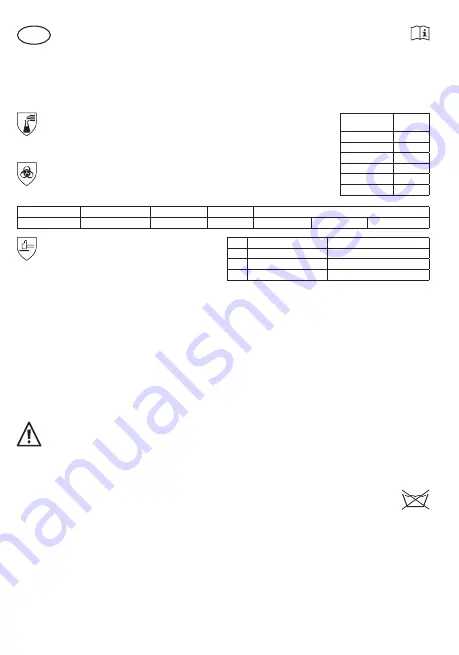
Information brochure in section 1.4 of Annex II of Directive 89/686/EEC Personal chemical resistant protective gloves Cat. III
EN 388, Mechanical risks
1st digit Abrasion resistance
(min. 0; max. 4)
2nd digit Cut resistance
(min. 0; max. 5)
3rd digit Tear strength resistance (min. 0; max. 4)
4th digit Puncture resistance
(min. 0; max. 4)
Article
Name
Size
EN 388
classification letter (KB) / Protection index
890
Vitoject®
8, 9, 10, 11
3101
D/4
F/6
G/4
Penetration
time in min.
Protection
index
> 10
1
> 30
2
> 60
3
> 120
4
> 240
5
> 480
6
The CE marking on this glove means that it meets the essential requirements for
in the European Directive EEC 89/686 concerning Individual Protection
Equipment (IPE): Harmlessness-Comfort-Dexterity-Sturdiness.
Protective Gloves conform to the EN 420. Approved to EN 374 and EN 388
according to Article 10 of Directive 89/686/EEC: IFA, Alte Heerstraße 111,
EN 374, Full-protection protective gloves against chemicals
The protective index refers to the permeation time determined during uninterrupted contact with the test chemical
under stable laboratory conditions. EN 374-3 =
Permeation
. A glove is resistant to chemicals, when a protection
index is achieved at least Level 2 in three of the chemicals listed below. The chemicals which have passed the test are
marked on the gloves with the letters A-L. (KB=classification letters.)
EN 374, Protection against bacteriological contamination
KCL chemical protective gloves have been penetration-tested to the highest performance level (3) set out in EN 374-2.
This quality limit equates to an AQL < 0.65.
D-53757 St. Augustin, Identification number: 0121Surveillance after 11 B of
Directive 89/686/EEC, chemical risks according to EN 374: same location as type test.
The identification number for testing and certification centre 0121 for EC type
testing and monitoring of quality assurance measures relates solely to the
content of EN 374-1: 2003 and the PPE Directive 89/686/EEC.
GB
WARNING !
Resistance to the chemicals listed was determined under laboratory
conditions and may be adversely affected by changes to physical
properties such as temperature, abrasion, stretching, etc. When
using highly corrosive chemicals, degradation is the most important
factor in the choice of protective gloves.
These protective gloves provide no protection against extreme cold
(< - 5 °C), heat (> 50 °C), electricity.
Do not use in the vicinity of moving machine parts. Risk of being
drawn into the machine.
Unusable when the gloves are cracked, porous and stiff.
Safety glove not approved for food contact.
Allergy Notice:
All gloves may contain traces of
Mercaptobenzoicthiazole.
Use:
The protective gloves you wear must be of the correct size. Note
that using undergloves may result in some usage restrictions. Check
the protective gloves for damage before you use them. Damaged
protective gloves must not be used under any circumstances.Prevent
the penetration of pollutants over the edge of the glove. Prevent
carryover of contaminants located on the glove and the cross-
contamination when removing gloves.
Cleaning:
The specified gloves are not washable.
Expiry date: With proper storage, no reduction in performance levels
within 36 months.
Storage/Transport:
Flat, dry, dark, with no additional weight load
in its original packaging, at a temperature of 5 °C - 25 °C. Protect from
sunlight and ozone.
Disposal:
If not contaminated with chemicals, gloves can be
disposed of in the household waste. If the gloves have been exposed
to chemicals, follow the disposal instructions of the manufacturer of
the chemicals.
For further information please contact.
KB Chemical
CAS no.
D
Dichloromethane
75-09-2
F
Toluen
108-88-3
G
Diethylamine
109-89-7
Содержание Vitoject 890
Страница 4: ......
Страница 5: ......
Страница 6: ......
Страница 34: ...www honeywellsafety com ...
Страница 35: ......










































